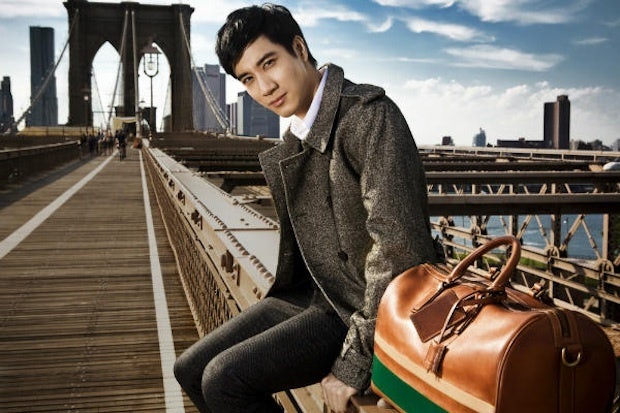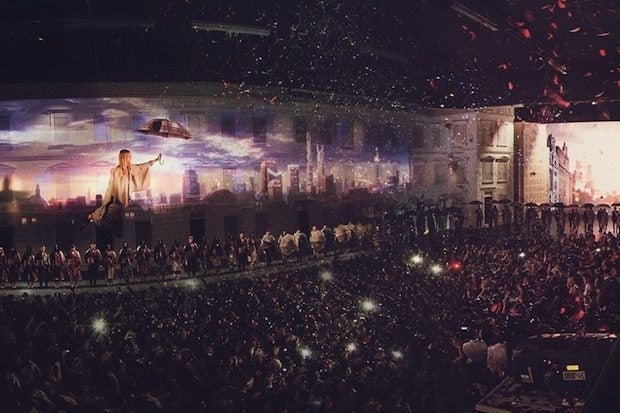
Louis Vuitton's Baidu Brand Zone.
Despite its recent slowdown thanks to China's decelerating GDP growth rate and government anti-corruption campaign, the Chinese luxury market remains a coveted consumer group with huge long-term potential.
Luxury in China is still growing—especially in the online sphere. The figures speak for themselves: China’s luxury e-commerce market is estimated to grow to about US$7 billion (45.3 billion yuan) by 2015. Even though the big players are already there, good newcomers with a well-designed marketing strategy would still be able to take advantage of the opportunities in the market.
A large part of a strong luxury strategy in China hinges on digital marketing. Keep reading for a list of seven important digital tools that are imperative for luxury success in the Chinese market.
1. Baidu Brand Zone#
Baidu Brand Zone is one of Baidu’s features that allows designing your own multimedia zone that goes ahead of every single answer on the first page when the user types a chosen specific keyword.
Choosing a keyword can be challenging, however. As said before, you can technically “choose” keywords—but you have to bid on them against other companies. If you win the auction, then those keywords are exclusively yours and unusable to other competitors. Choosing the right keywords can make this other feature very useful indeed.
What can you do with it?
You can post anything you want, from text to music or video. This is definitely a big advantage since Baidu’s search engine results page (SERP) does not allow normal websites to post anything but text in the answer page. The rule of thumb that does not change with people going online is the more attractive you are, the more people will come to you.
Therefore, having such an attractive space should significantly increase your number of potential clients.
The Baidu Brand Zone has potential doesn’t come cheap: EUR11,000 ( US$15,000) per month to have your own. That is a steep cost only a few, well-established companies could afford. However, there are much more cost efficient methods that can be used.
2. KOLs (Key Opinion Leaders)#
Selling luxury products is first and foremost selling an image. Some would even say a dream. What better is there than using those whose image is already well-established? Those epitomizing the dreams thousands even millions?
We are talking about the KOL, or key opinion leader.
There are two categories of KOL: Traditional celebrities and online celebrities. Traditional celebrities include renowned actors and singers such as Leehom Wang (王力宏). This young man has already won a Golden Melody Award (Taiwan’s Grammy) four times.

Actor and singer Leehom Wang in a Coach ad. (Coach)
These celebrities already have a high visibility in the classic media or in the social networks. Having them use or wear your products and making sure they know it, is a good way to attract their audience attention toward your brand, thus quickly increasing your number of potential customers.
In addition, there are those such as less prominent celebrities or bloggers, whose reputations in real life are outmatched compared by the ones they have online, especially on Weibo, the Chinese Twitter.
For instance, actress, TV host, and singer Xie Na (谢娜) is not one of China's most famous celebrities, but has over 50 million followers on Weibo.

Xie Na's Weibo account is larger than life.
3. High-Quality Multimedia#
Luxury, as it has been said earlier, is all about selling dreams, customer experience, and prestige. Therefore, you can use nothing but high-quality media to promote you brand. See the Youku videos below by Versace and Dior for key examples:
In addition, luxury buyers enjoy having a top-notch website experience: a well-designed official brand site giving a good feeling, with high-resolution pictures and high-quality, highly sophisticated videos is a necessity.
4. O2O (Online to Offline)#
An online-to-offline (O2O) strategy uses the potential of both online and offline marketing. Most of the time, it is all about leading the potential customer with online strategies to offline shops where specialized sellers will transform customers into sales. One example is QR codes giving information about the brand or a premium discount for a limited amount of time.
5. Quality, Not Quantity In Social Networks#
These days, in the social networks market, the leaders of the pack are Weibo and WeChat. For a luxury brand, the number of followers does not really matter because it's all about interaction and discussion. The more they talk about, it the better your brand awareness will become.
In order to do that, you need to post quality content about your brand and have your community members interact with each other.
Something to remember: Weibo keeps bragging about its 500 million registered users, although “only” 46 million of them truly use it. Zombie accounts are completely useless for a luxury brand because what matters here is the opinion of the customers.
6. Storytelling#
The strong Chinese taste for multimedia campaigns is a fact. Among these, storytelling definitely plays its part. A well-designed storytelling campaign will strongly affect Chinese customers. By inspiring an emotional connection with the brand, it is possible to increase your number of potential buyers. These campaigns are all about passion rather than logic and feelings to persuade, not convince. You simply have to see this storytelling about wines or the results of Burberry’s campaign in Shanghai in April this year to understand how effective it is.

Burberry, which heavily promotes events such as the "London in Shanghai" show featured above, is set to benefit from its mass appeal in China. (Burberry)
7. Digital PR#
A good digital PR strategy is critical for developing a luxury brand. Image and social prestige brought by owning luxury goods are the essence of luxury. Threading with caution and being efficient and quick to react are necessary. With digital media in China, the common phrase “it takes years to build a strong reputation and seconds to destroy it” could not be truer given how fast the information spreads.
In order to avoid a catastrophe, you must keep good relationships with Chinese journalists that can publish about your brand or the services you can offer. In addition, journalists will take part in positioning your brand on the market and not necessarily the way you would have wanted it to be. You must do everything you can to make sure that everything matches your marketing strategy.
Conclusion#
The China market is still undoubtedly the place to be when it comes to luxury. However, it has a number of key problems that need to be overcome one way or another. Cultural differences, market differences, and language barriers are some of those issues. To set foot quickly and easily on this land of all opportunities, you need industry experts to create a strong digital strategy.
Olivier Verot is the founder of Gentlemen Marketing Agency, and specializes in digital marketing solutions for the Chinese market. Find more information about the author on Google Plus or LinkedIn.